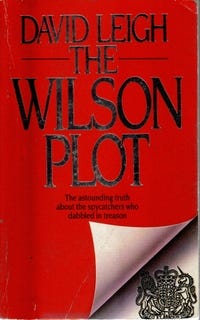Book Review - The Wilson Plot, by David Leigh
David Leigh, The Wilson Plot: The Astounding Truth about the Spycatchers who dabbled in Treason (Heinemann, 1988).
One of Britain's top investigative journalists describes how elements of MI5 and the CIA turned on the British Prime Minister.
The story has its roots its in the cold war paranoia engendered by the Cambridge spy ring, a brilliant Soviet coup that penetrated right to the heart of western intelligence. When KGB defector Anatoly Golitsyn claimed that Labour leader Hugh Gaitskell had been murdered by the KGB to make way for Harold Wilson, senior counterintelligence officers such as James Angleton of the CIA and Peter Wright of MI5 were prepared to believe him.
This helped pave the way for a covert campaign against Wilson that would climax during his second government in the mid-1970s. Although, this campaign would be revealed in Wright's book Spycatcher, Leigh argues that Wright concealed his own role. Leigh had access to a number of Wright's unpublished manuscripts, a source he prefers to the ghostwritten Spycatcher.
One of Leigh's central arguments for the proposition that elements of the intelligence services were plotting against Wilson is that in August 1975, Wilson confronted first Maurice Oldfield, head of MI6, and then Michael Hanley, head of MI5, and the two service chiefs admitted as much.
Oldfield gave an account of the first conversation to the journalist Chapman Pincher and to MI6 officer Anthony Cavendish. Wilson discussed both conversations with journalist Barrie Penrose, the latter with Pincher as well.
Leigh also briefly discusses the tesitmony of Colin Wallace, the Army Information Officer from Northern Ireland who revealed the existence of MI5's Clockwork Orange smear campaign.
This is a powerful body of evidence of the existence of a plot that neither MI5 nor the British Government has admitted to this day.
More concise than the encyclopaedic Smear, by Ramsay and Dorril, for which it is an important source, The Wilson Plot is essential reading for anyone interested in this murky period of British political history.
This review was originally published at tom@tomgriffin.org on 15 June 2007.


